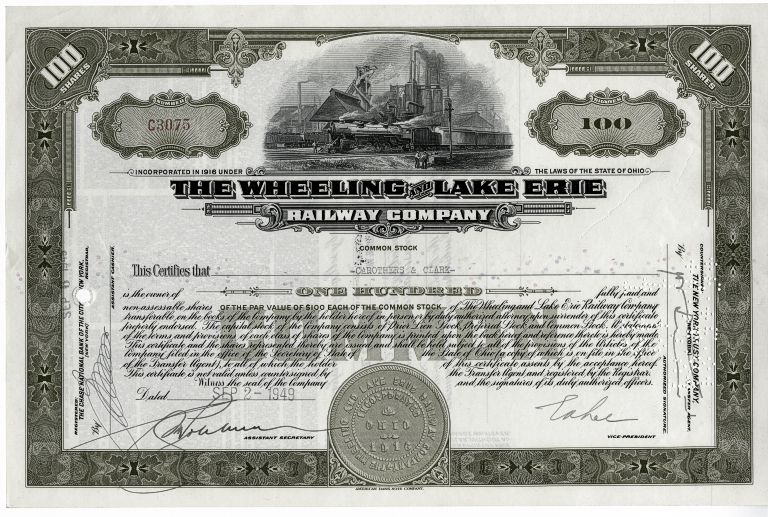Beautifully engraved olive stock certificate from the Wheeling and Lake Erie Railway Company issued in 1949. This historic document was printed by the American Banknote Company and has an ornate border around it with a vignette of a train passing a millsite. This item has the signatures of the Company's officers. 
Certificate Vignette Wheeling and Lake Erie Railway's (AAR reporting mark WLE) oldest predecessor rail line began in Ohio, with the organization of the Carroll County Rail Road on March 9, 1850. The Wheeling and Lake Erie Railroad was established on April 6, 1871 and was first built as a 3-foot narrow gauge line between Norwalk, Ohio and Huron, Ohio. Service began on the new line on May 31, 1877. However, the new road was unable to attract regular traffic, or financing for expansion, and had closed within two years. With investment by railroad financier Jay Gould in 1880 and financial reorganization, the line was converted to standard gauge and construction began again. Service from Huron to Massillion, Ohio was opened on January 9, 1882 and new lines were constructed that eventually reached the Ohio River and Toledo. The WLE also developed new docks on Lake Erie at Huron that opened May 21, 1884 when the first cargo of iron ore was received. In 1880 another 3-foot narrow gauge line, the Connotton Valley Railway, was formed; building north from Canton, Ohio to Cleveland and then south to Coshocton, Ohio and Zanesville. The Connotton Valley became the Cleveland, Canton & Southern Railroad and was converted to standard gauge in one day on November 18, 1888. The Cleveland, Canton & Southern Railroad joined the WLE in 1899 after its purchase at forclosure sale, becoming WLE's Cleveland Division. At its height, the WLE ran from the Pittsburgh region (through a connection with the Wabash-Pittsburgh Terminal, later the Pittsburgh and West Virginia Railway) to Lake Erie at Huron and Toledo. However, the mainlines of the WLE never reached outside Ohio's borders. It also ran from Cleveland to Zanesville, with the lines crossing at Harmon, just east of Brewster, Ohio, which became the location of WLE's corporate headquarters and locomotive shops. With two busy main stems crossing on the map of Ohio; the road's nickname for many years was "The Iron Cross." Ironically, the mainline of the WLE never actually reached Wheeling, West Virginia. However, a branch between Steubenville, Ohio and Martins Ferry was completed in 1891, which led to an indirect connection to Wheeling via a subsidiary, the Wheeling Bridge and Terminal Company. The WLE began producing locomotives at its Brewster, Ohio shops in 1910, and boasted one of the finest locomotive producing facilities in the country. Over the years, the WLE built and rolled boilers and erected fifty of their own steam engines, a feat never tried by many larger and more famous railroads. The Wheeling & Lake Erie was jokingly called the "Wailing and Leg Weary" but, after several early financial embarrassments, finally found prosperity in its later life. The WLE was leased by the Nickel Plate Road (NKP) in 1949. The Nickel Plate Road merged with Norfolk and Western Railway in 1964. Norfolk and Western merged with the Southern Railway in 1982, forming the Norfolk Southern Railway (NS). Re-birth as a regional railway In 1990, Norfolk Southern Railway sold portions of their lines in Ohio and Pennsylvania, including most of the original lines of the former WLE, the Akron, Canton and Youngstown Railroad and the Pittsburgh and West Virginia Railway to a new regional railroad, the Wheeling and Lake Erie Railway (reporting mark WE) that operates today. At its formation, trackage rights were extended to the new organization to serve several limestone quarries in the Bellevue, Ohio area and with CSX Transportation from Connellsville, Pennsylvania to Hagerstown, Maryland, a remnant of the old Alphabet Route of which the original WLE was a part. The only portions of the original WLE not owned by the current WE are the NS line west of Bellevue, (though WE now has trackage rights to Toledo on this line, obtained after the Conrail split in 1999); the former Cleveland Division line south of Harmon (Brewster) that was sold to Ohio Central Railway (OHCR) by NS in 1986, and the Huron, Ohio docks trackage. The Huron Branch, WLE's first line between Norwalk and Huron, was acquired by WE but was never activated north of the Norwalk city limits and was later removed in its entirety. WE still serves the Huron Docks using trackage rights on NS' former Nickel Plate Road line from Bellevue and a connecting line to the docks built by the NKP in 1952. A few other small portions of the original WLE have been abandoned and/or replaced with trackage rights on parallel lines by WE. WE also has trackage rights to Lima, Ohio, that originally used CSX lines from Carey, Ohio to Upper Sandusky, Ohio to Lima, but after the lease of the CSX line (the former Pennsylvania Railroad main line) by RailAmerica's Chicago, Fort Wayne and Eastern (CF&E), WE now uses trackage rights from its lines at New London, Ohio to Crestline, Ohio on CSX, then west on the CF&E to Lima. These trackage rights were also a result of the Conrail split. WE lines interchange with three major Class I railroads (Canadian National, CSX, and Norfolk Southern). Many of the major commodities remain the same as in the early days: coal from southeastern Ohio; iron ore from the Great Lakes region; steel from five different mills; aggregates from four quarries; plus chemicals, forest products, and grain, generating approximately 130,000 carloads annually. Branch lines reach as far south as Benwood, West Virginia (just south of Wheeling) and as far east as Connellsville, Pennsylvania. The WE joins the Southwestern Pennsylvania Railroad at Owensdale, Pennsylvania. The WE currently operates about 850 miles of track. History from Wikipeida and OldCompanyResearch.com.

Certificate Vignette








